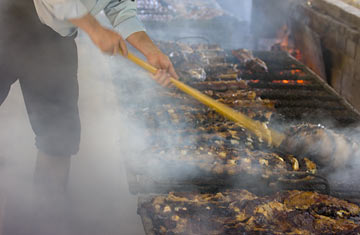
This Fourth of July weekend, millions of Americans will huddle around outdoor pits, ovens and grills to slowly cook themselves meaty, patriotic dishes slathered in sauce. Barbecue is about as red, white and blue as American cuisine gets, and for true carnivores, the only real question is how to save room for seconds.
Let’s first get one thing straight: merely throwing meat on a grill is not barbecue — at least not in the traditional sense. While novices (and Yankees) may believe that anything covered in KC Masterpiece counts as barbecue, the real thing is cooked over indirect heat — usually a wood fire — for a reallylong time (sometimes for as many as 18 hours). The resulting flavor is a combination of smoke, meat juices, fat and whatever spices or rub have been added.
No one is really sure where the term barbecue originated. The conventional wisdom is that the Spanish, upon landing in the Caribbean, used the wordbarbacoa to refer to the natives’ method of slow-cooking meat over a wooden platform. By the 19th century, the culinary technique was well established in the American South, and because pigs were prevalent in the region, pork became the primary meat at barbecues. Corn bread emerged as the side dish of choice, owing largely to the fact that in humid Southern climates, corn grew better than wheat (which was prone to fungal infections). Barbecue allowed an abundance of food to be cooked at once and quickly became the go-to menu item for large gatherings like church festivals and neighborhood picnics.
Barbecue varies by region, with the four main styles named after their place of origin: Memphis, Tenn.; North Carolina; Kansas City; and Texas. Memphis is renowned for pulled pork-shoulder doused in sweet tomato-based sauce (eaten on its own or as a sandwich). North Carolina smokes the whole hog in a vinegar-based sauce. Kansas City natives prefers ribs cooked in a dry rub, and Texans … well, Texans dig beef. Eastern Texas’ relative proximity to Tennessee puts it in the pulled-pork camp, but in the western segment of the Lone Star State, you’re likely to find mesquite-grilled “cowboy-style” brisket. Locals defend their region’s cooking style with the sort of fierce loyalty usually reserved for die-hard sports fans. Just as you’re better off not mentioning the Yankees to a Red Sox fan, it’s probably best not to proclaim your love for Texas beef to anyone from Tennessee.
Because barbecue doesn’t require expensive cuts of meat — why bother when you’re just going to slather it in sauce and cook it ’til it falls off the bone? — it became a dietary staple for impoverished Southern blacks, who frequently paired it with vegetables like fried okra and sweet potatoes. The first half of the 20th century saw a mass migration of African Americans from the rural South to Northern cities, and as they moved, they took their recipes with them. By the 1950s, black-owned barbecue joints had sprouted in nearly every city in America. Along with fried chicken, corn bread and hush puppies, barbecue came to be known as a “soul food” dish. To this day, there is a strong connection between the cuisine and the African-American community.
Other countries barbecue in their own style. Korean barbecue features thin slices of beef or pork cooked and served with rice. Argentina has asado, or marinade-free meat cooked in a smokeless pit. And of course, there’s Mongolian barbecue, which is neither barbecue nor of Mongolian origin but rather a type of stir-fry recently invented in Taiwan. But true barbecue is distinctly American. So this Fourth of July, when the parades have ended and the sun starts to go down, throw some meat on the grill and cook yourself a true American classic. Patriotism never tasted so delicious.
More Must-Reads from TIME
- Inside Elon Musk’s War on Washington
- Why Do More Young Adults Have Cancer?
- Colman Domingo Leads With Radical Love
- 11 New Books to Read in February
- How to Get Better at Doing Things Alone
- Cecily Strong on Goober the Clown
- Column: The Rise of America’s Broligarchy
- Introducing the 2025 Closers
Contact us at letters@time.com